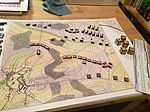Johann Christian Ludwig Hellwig
This article needs additional citations for verification. (March 2014) |
Johann Christian Ludwig Hellwig (8 November 1743 in Garz/Rügen – 10 October 1831 in Braunschweig) was a German entomologist and wargame designer.
Biography
After studies of mathematics and natural history at the university of Frankfurt, he became, in 1766, adviser to prince Wilhelm Adolf von Braunschweig at the time of his voyage in the south of Russia.
In 1771, he taught in two colleges of Brunswick then he became professor of philosophy of the University of Helmstedt. In 1790, he taught mathematics and natural science at the military academy of Braunschweig, where famously he was the "Master of Pages" (Pagenhofmeister). His attempts to instruct the young in military sciences inspired his work on wargames.
He exerted a great influence on his pupils.[citation needed] He was the tutor and the father-in-law of the German entomologist Johann Karl Wilhelm Illiger (1775–1813), who became director of the zoological garden of Berlin, of the mineralogist Gottlieb Peter Sillem (who succeeded him at the school of Braunschweig) and the count Johann Centurius Hoffmannsegg (1766–1849).
His work in the taxonomy of the insects in collaboration with Illiger and Hoffmannsegg is famous and was the entomological origin of the collections of the University of Berlin (in the present day and since a long time, separated from the university and kept in the Natural History Museum of Berlin).
Hellwig's Wargame

He was also the inventor of kriegsspiel (literally war game), a sophisticated variant of chess which had much success in its time. Hellwig published the first edition of his kriegsspiel in 1780 as Versuch eines aufs Schachspiel gebaueten taktischen Spiels von zwey und mehreren Personen zu spielen, or "Attempt to build upon chess a tactical game which two or more persons might play."[1] His objective was to try to create a chess-like game that better reflected the military science of the day, especially the behavior of infantry, cavalry and artillery. His initial kriegsspiel vastly expanded the chess board (he usually employed a board of 49 ranks by 33 files, for 1617 squares) and radically changed the behavior of pieces, as well as introducing several new pieces. Rather than depicting only the abstract space of chess, his board had varying terrain types, including mountains, swamps and water squares. Rather than capturing the king to win, one had to occupy an enemy fortress. Hellwig further refined his game over the next twenty years, publishing in 1803 his revised Das Kriegsspiel, which dispensed with the trappings of chess entirely and substituted for chess pieces new units representing the military branches of his era. His game spawned numerous contemporary imitators, and its fundamental innovations formed the basis of the hobby board wargames pioneered by Avalon Hill in the twentieth century.
Sources
Translated from French Wikipedia
References
- ^ Peterson, Jon (2012). Playing at the World. San Diego CA: Unreason Press. p. 213. ISBN 978-0615642048.

